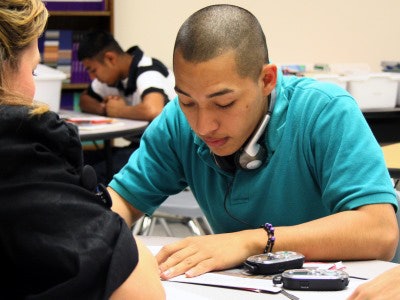
Malfaro, who spoke at the Hispanic Association of Colleges and Universities’ 29th Annual Conference at the Fontainebleau Hotel, said the United States is in a “crucial period of public education reform” and struggles to address the needs Hispanic learners ― who are poorer than their White counterparts and often fall victim to a system based heavily on standardized testing.
“This isn’t just a Texas thing or a California thing,” Malfaro said. “We know now that about a quarter of our students nationwide are Latino and we have over five million English language learners.”
Hispanic-serving institutions (HSIs) are 12.1 percent of nonprofit colleges and universities, yet enroll 20 percent of all students and 58.9 percent of all Hispanic students, according to a Hispanic Association of Colleges and Universities (HACU) report. The Department of Education also provides HSIs ― or schools where 25 percent of full-time students are Hispanic ― with academic grants.
Throughout HACU’s weekend-long conference from Oct. 10 to 12, educators, both K-12 and higher level, talked about research and effective programs that empowered Hispanic students to take ownership of their education and in the process encouraged schoolwide and community collaboration.
In one session, Timothy Hall, president of Mercy College in Dobbs Ferry, New York, pointed to a case in 2006 where 60 percent of students at Austin Peay State University in Clarksville, Tennessee, lacked college-level math and reading skills.
Hall, who was the president at the time, said Austin Peay restructured how they taught underperforming students after the Tennessee Board of Regents, one of two governing higher-level boards in the state, started penalizing universities for offering remedial coursework.
Austin Peay found that 1 in 10 students who started college by taking remedial or developmental course went on to graduate.
“How can we be satisfied with this number?” Hall said. “I think one of the reasons was first that we thought that it really wasn’t our problem. We could point our finger at various other elements within society to identify why it was that we had so many students coming to us, unprepared for college math and English.”
Hall said Austin Peay removed 52 remedial math courses the year after the penalties were implemented, saved more than $210,000 a year and 70 hours of classroom space.
Next, Austin Peay adopted a Student Learning Assistance program, first used in 1993 at Ferris State University in Michigan, that paired college-level courses with required peer-to-peer tutoring. Hall said the co-requisite class removed the stigma associated with remedial courses and “forced students to do the work.”
While the school is still collecting data to put numbers on the program’s success, Hall said universities will receive students performing below level and need to be “relentlessly discontent with poor results” and ask if the institutions have “created the conditions for success.”
Miami Dade College (MDC) Academic and Student Affairs Dean Joaquin Martinez and Student Affairs Vice Provost Kathy Maalouf said in a session on Sunday that institutions can reallocate existing resources within the school ― including $1.5 million for senior advisers at MDC and less than 1 percent of the college’s $420 million budget ― to improve student success.
At MDC, where 71 percent of students are Hispanic, school officials developed a new program to support students from high school and into graduation. The program, Martinez said, was data driven, hands-on, and most importantly, called on teachers and faculty for input.
“Some of our harshest critics were right,” Martinez said. “It’s OK to be wrong and reassess along the way.”
The Shark Academy and First Year Experience program has changed and evolved since it was launched four years ago, starting from a team of 80 faculty members to 1,000. Maalouf said the school’s advisers are using data to understand their dynamic student body.
HACU CEO and President Antonio R. Flores said that, while educators are working with students on the ground, elected officials need to help educate students by increasing funding to students who need it the most ― especially when those students are projected to be a majority of the workforce.
According to a study by Pew, the Hispanic population reached a new high of 55.4 million, or 17.4 percent of the total U.S. population, in 2014. The median age for Hispanics in the U.S. is 27 years old, compared to 37 years old for the country.
“The economic prosperity of this country is increasingly dependent on the educational success of Latinos,” Flores said. “It’s not just about getting Hispanics in better shape, but the future of this country because the workforce will be more brown.”





















